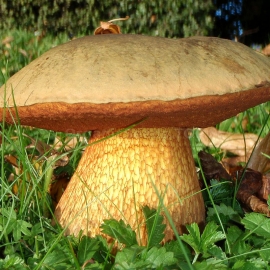 EXCLUSIVE
EXCLUSIVE




Lurid Bolete / Suillellus luridus - Organic Mushroom's Dry Mycelium
6.10 €
Suillellus luridus (formerly Boletus luridus), commonly known as the lurid bolete, is a fungus of the bolete family, found in deciduous woodlands on chalky soils in Asia, Europe, and eastern North America.
-
Organic Lurid Bolete Mushroom's Dry Mycelium
Suillellus luridus (formerly Boletus luridus), commonly known as the lurid bolete, is a fungus of the bolete family, found in deciduous woodlands on chalky soils in Asia, Europe, and eastern North America. Fruit bodies appear in summer and autumn and may be abundant.
It is a solid bolete with an olive-brown cap up to 20 cm (8 in) in diameter, with small red pores on the underside. The stout ochre stem reaches 8–14 cm (3–6 in) high and 1–3 cm (0.4–1.2 in) wide, and is patterned with a red mesh-work. Like several other red-pored boletes, it stains blue when bruised or cut.
Though edible when cooked, it can cause gastric upset when eaten raw and can be confused with the poisonous Boletus satanas, though the latter species has a pale cap; as a result, some guidebooks recommend avoiding consumption altogether. When consumed with alcohol, Suillellus luridus has been implicated in causing adverse reactions similar to those caused by the compound coprine, though laboratory testing has not revealed any evidence of coprine in the mushroom.
Suillellus luridus is a stout fungus with a thick yellow-olive to olive-brown convex cushion-shaped cap that can reach 20 cm (8 in) in diameter. The cap colour tends to darken with age, and regions of red, orange, purple, brown, or olive-green can develop in maturity. The cap surface is tomentose (velvety), becoming smoother with old age, and sticky in wet weather.
The pore surface is initially dark red before turning orange-red, and has a lighter-coloured zone encircling the margin. There are 2–3 circular pores per millimetre, and the tubes are 1–2 cm (0.4–0.8 in) deep. The tubes are shorter around the cap margin and close to the stem, where they form a circular depression. Initially pale yellow, the tubes gradually become olive-yellow and then bluish-green upon exposure to air.
A characteristic feature is the presence of a maroon layer between the tubes and the flesh. The thick stem is 8–14 cm (3–6 in) tall and 1–3 cm (0.4–1.2 in) wide, and bears a distinctive orange-red meshlike pattern on a paler yellowish or ochre background. The flesh is yellowish, with red marks in the cap, and stains an intense dark blue when bruised or broken. There is a faint sour smell, and the taste is described as mild.
Variety queletiformis can be distinguished from the main form by the reddish discolouration of the stem base that occurs both on the exterior surface and in the flesh. Variety rubriceps has a deep crimson red cap, while var. lupiniformis has a pale yellow or dirty ochre cap, sometimes with pink tones throughout.
